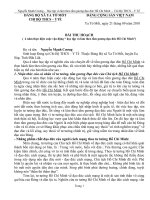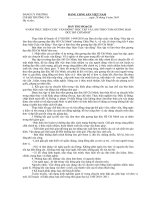ch. 4 project and private benefit-cost analysis
Bạn đang xem bản rút gọn của tài liệu. Xem và tải ngay bản đầy đủ của tài liệu tại đây (286.85 KB, 33 trang )
© Harry Campbell & Richard Brown
School of Economics
The University of Queensland
BENEFIT-COST ANALYSIS
BENEFIT-COST ANALYSIS
Financial and Economic
Financial and Economic
Appraisal using Spreadsheets
Appraisal using Spreadsheets
Ch. 4: Project and Private
Benefit-Cost Analysis
Private Benefit-Cost Analysis
Deriving ‘Project’ and ‘Private’ cash flows:
•
Project cash flow refers to cash flow for the overall project
•
At market prices
•
Irrespective of who gains or loses.
Private Cash Flow
•
at market prices
Private cash flow refers to cash flow to the individual investor
engaged in project.
•
after allowing for loan service costs
•
after payment of profits taxes
Deriving Private Cash Flow
To derive private cash flow, we begin by calculating overall
project cash flow.
•
Debt/financing inflows and outflows to creditors
•
Taxes paid to government
We then subtract from the project cash flow:
Cash Flow on Equity
•
The private cash flow is the cash flow on the investor’s
own funds or ‘equity’.
•
Project cash flow minus debt cash flow = cash flow on
equity (before tax).
•
Cash flow on equity is the residual: what is left over after
servicing debt.
Deriving Project Cash Flow
To derive project cash flow we need to be mindful of some
important concepts and conventions:
•
Inflation: usual to use constant prices with a real
discount rate (otherwise, nominal prices with nominal
interest rate). See table 4.1.
•
Incremental rather than total cash flow: ‘with project’
less ‘without project’ cash flow. See table 4.2.
Deriving Project Cash Flow
•
Interest on debt excluded from cost to avoid double
counting.
•
Depreciation excluded from cost to avoid double counting.
(See table 4.3)
•
Changes in working capital appear under investment costs
at the beginning and end of the project. (See table 4.4)
Debt Financing Cash Flow
To derive debt financing flow, for each period, from the
borrower’s perspective, begin with project cash flow, then:
•
Add all loan receipts in each period
•
Subtract all interest payments in each period
•
Subtract all principal repayments in each period
Private Cash Flow (Equity)
To derive private cash flow, for each period, before tax:
•
Add debt financing flow to project cash flow.
(See table 4.5)
Project = Debt + Equity
Cash flow from the perspective of lenders and investors adds
up to Project Cash Flow. (See table 4.6)
Deriving IRR on Equity
We can calculate IRR on each ‘component’ of cash flow:
project, debt and equity.
•
First, calculate IRR on Project Cash Flow:
when NPV = 0
-5000 (1.0) + 1000(AF
10
) = 0
AF
10
= 5000/1000
= 5
IRR = 15%
Deriving IRR on Equity
•
Second, calculate IRR on Debt Financing Cash Flow:
when NPV = 0
3512(1.0) - 500(AF
10
) = 0
AF
10
= 3512/500
= 7.024
IRR = 7%
Deriving IRR on Equity
•
Third, calculate IRR on Equity Cash Flow:
when NPV = 0
-1488(1.0) + 500(AF
10
) = 0
AF
10
= 1488/500
= 2.976
IRR = 31%
Gearing and Debt: Equity Ratio
•
IRR on Equity + IRR on Debt = Project IRR
•
Project IRR minus IRR on Debt = IRR on Equity
–
By changing the ratio of debt to equity, you can change the
IRR on equity, given the Project IRR and IRR on debt.
An Example of Gearing
•
Assume debt:equity is $60:$40
•
Assume Project IRR = 10%,
and, cost of debt = 5%
–
What is the IRR on equity?
HINT: IRR on Debt + IRR on Equity = Project IRR
An Example of Gearing
IRR on project = 0.6(IRR on debt)
+ 0.4(IRR on equity)
10% = 0.6(5%) + 0.4(x%)
0.4(x%) = 10% - 3%
IRR on equity = x% = 7/0.4
= 17.5%
More Gearing
IRR on project = 0.8(IRR on debt)
+ 0.2(IRR on equity)
10% = 0.8(5%) + 0.2(x%)
0.2(x%) = 10% - 4%
IRR on equity = x% = 6/0.2
= 30%
Implications of Gearing
•
If an investor can borrow on concessional terms, a ‘bad’
project can appear ‘good’.
•
If an investor borrows on unfavourable terms, a ‘good’
project might appear ‘bad’.
Calculating After Tax Cash Flow
•
Some items of project cost that do not enter into a project's
cash flow directly affect the net cash flow indirectly through
their effect on the project's taxable profits.
•
The analyst needs to prepare a separate statement to calculate
the project's taxable profits.
•
The two items that are not part of the project’s cash flow that
enter into the calculation taxable profits are:
– depreciation
– interest on debt
Calculating After Tax Cash Flow
•
These should be added to the operating costs in the project
cash flow for the purpose of calculating taxable profits.
•
Taxes due are then calculated as some % of taxable profits
and are deducted from the private cash flow to derive the
after tax private cash flow.
Calculating Taxes
It should be noted that tax laws vary from one country or state to
another. In most cases, losses can be written off profits earned
elsewhere or of future profits.
•
This implies that there could be negative taxes in some
project years.









